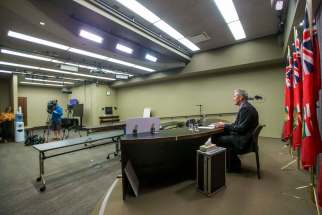Invest in health care to rise above second wave
Read this article for free:
or
Already have an account? Log in here »
To continue reading, please subscribe:
Monthly Digital Subscription
$0 for the first 4 weeks*
- Enjoy unlimited reading on winnipegfreepress.com
- Read the E-Edition, our digital replica newspaper
- Access News Break, our award-winning app
- Play interactive puzzles
*No charge for 4 weeks then price increases to the regular rate of $19.00 plus GST every four weeks. Offer available to new and qualified returning subscribers only. Cancel any time.
Monthly Digital Subscription
$4.75/week*
- Enjoy unlimited reading on winnipegfreepress.com
- Read the E-Edition, our digital replica newspaper
- Access News Break, our award-winning app
- Play interactive puzzles
*Billed as $19 plus GST every four weeks. Cancel any time.
To continue reading, please subscribe:
Add Free Press access to your Brandon Sun subscription for only an additional
$1 for the first 4 weeks*
*Your next subscription payment will increase by $1.00 and you will be charged $16.99 plus GST for four weeks. After four weeks, your payment will increase to $23.99 plus GST every four weeks.
Read unlimited articles for free today:
or
Already have an account? Log in here »
Hey there, time traveller!
This article was published 23/06/2020 (1999 days ago), so information in it may no longer be current.
It wasn’t the answer pollster Léger was expecting when Manitoba businesses were asked what actions the provincial government should take to get the economy back on track.
The No. 1 response: invest in health care to prepare for a possible second wave of COVID-19.
That’s according to 40 per cent of respondents in a recent Léger poll, conducted for the Winnipeg Chamber of Commerce and Manitoba Chambers of Commerce. The number was even higher for small businesses, at 48 per cent.
Support for local tourism came in second (33 per cent); reducing regulations was third (31 per cent).
“I somewhat expected the support for tourism and reducing red tape, but the investment in health care was interesting,” Andrew Enns, Léger executive vice-president, said in a news release.
“I suspect that is a message to government that businesses cannot survive a second mass shutdown should infections increase significantly later in the year. The health-care system has to get us through.”
That’s an important point, one Manitobans may have to come to terms with.
What is not an option, as many businesses alluded to in the survey, is another shutdown of the economy.
Manitoba still hasn’t had a fulsome debate on how government should respond to the expected second wave of COVID-19, largely because the province (and the rest of the world) is still grappling with the first.
It likely peaked in Manitoba weeks ago, but fresh outbreaks in southern U.S. states such as Arizona, Texas and Florida show Canada remains vulnerable if it were to reopen its border.
However, with the right protections in place (including continued international travel restrictions), Manitoba and the rest of the country are well-positioned to contain the spread of the disease through the summer months.
But what about the possibility of a second wave in the fall or over the winter? Public health officials have no idea when or if that will happen; if it does, governments will have some tough decisions to make.
What is not an option, as many businesses alluded to in the survey, is another shutdown of the economy.
With millions still out of work and hundreds of businesses forced to permanently close, Canada and Manitoba can’t afford another round of stay-at-home orders. The economy, already at near-collapse level, would undoubtedly fall into a deep and prolonged depression if that were to occur. Governments would not have the borrowing capacity to shell out the hundreds of billions needed in subsidies, as they did during the first wave.
The economic carnage, poverty, and social unrest of a second closure would far outweigh the benefits of containing the novel coronavirus.
That’s not to say society would operate on a business-as-usual basis. The economy will not return to normal any time soon, not until a safe, effective vaccine is available for widespread use (or long-lasting herd immunity is established).
Until then, large gatherings are out and social-distancing rules will remain in place. The use of non-medical face masks where social distancing cannot be maintained will be part of the new normal. Some people may continue to work from home.
Manitoba still hasn’t had a fulsome debate on how government should respond to the expected second wave of COVID-19, largely because the province (and the rest of the world) is still grappling with the first.
Many of the measures taken since the beginning of the pandemic will remain in place. Manitoba has brought up its daily testing capacity to 2,000 a day; there are now ample contact tracing resources in place to track new cases; hospital resources have been expanded.
Despite new, cautious visitation rules for residents at personal care homes, those centres will remain largely locked down for the foreseeable future. International travel bans can, and should, be extended into the fall.
The whole manner in which Manitobans now work, shop and play has changed.
Public health officials could reinstate some orders if a second wave hits, but shutting down the economy to the extent the province did in March and April, including closing schools, is a non-starter.
What it needs to do above all else, as Manitoba businesses have recommended, is invest as much as possible into health care (including personal protective equipment).
Hospitals were not overwhelmed with COVID-19 patients during the first wave of the pandemic, as many had feared. That could change if a second wave hits.
tom.brodbeck@freepress.mb.ca

Tom has been covering Manitoba politics since the early 1990s and joined the Winnipeg Free Press news team in 2019.
Our newsroom depends on a growing audience of readers to power our journalism. If you are not a paid reader, please consider becoming a subscriber.
Our newsroom depends on its audience of readers to power our journalism. Thank you for your support.







